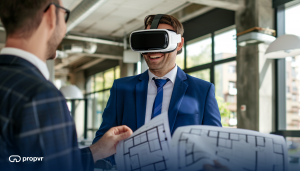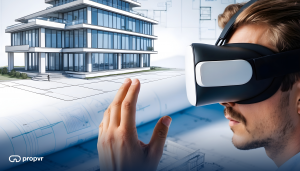The real estate industry has long relied on traditional methods to market and sell properties—open houses, brochures, and static photos have been the norm. However, as technology evolves, so does how we approach property sales. Virtual Reality (VR) is emerging as a game-changer, redefining how real estate transactions are conducted and offering a new level of engagement for buyers and sellers alike.
A New Dimension in Property Viewing
Visiting multiple properties in person can be time-consuming and overwhelming for many potential buyers. VR is changing this by allowing buyers to take immersive virtual tours of properties from their homes. With VR, they can explore every corner of a property, get a feel for the space, and even envision how it might look with different furnishings—all without stepping foot on site. This new dimension of property viewing is more convenient and engaging, making it easier for buyers to find the perfect home or investment.
Use Case: Virtual Open Houses Real estate agents can host virtual open houses where multiple buyers can explore the property simultaneously in a shared VR environment. This allows for a more interactive and social experience, where agents can answer questions in real time and guide prospective buyers through the property as if they were physically present.

Expanding the Market Reach
Traditionally, real estate transactions have been limited by geography. Buyers had to be in the same city—or at least the same country—to view and purchase a property. VR is breaking down these barriers by enabling remote property viewing. Whether a buyer is in New York, London, or Tokyo, they can virtually visit properties worldwide. This expanded market reach is particularly beneficial for luxury real estate and investment properties, where international buyers are often key players. By offering VR tours, real estate agents can attract a global audience, opening up new opportunities for sales.
Use Case: International Property Showcases Real estate firms can create VR showcases of luxury properties aimed at international buyers. These virtual experiences can be tailored to highlight unique features and amenities, allowing potential buyers worldwide to experience the property as if they were in person, significantly increasing the chances of a sale.

Enhancing the Sales Experience
Buying a property is one of many people’s most significant financial decisions. VR enhances this experience by providing a more interactive and informative way to explore properties. Potential buyers can walk through different layouts, visualize various design options, and even experience the ambience of a neighbourhood—all in a virtual environment. This level of engagement helps buyers make more informed decisions and feel more confident about their purchase, ultimately leading to smoother transactions and higher satisfaction.
Use Case: Virtual Tours VR platforms can offer customizable virtual tours where buyers can switch between different floor plans, view the property at other times, or even experience various interior design options. This personalization helps buyers visualize the space as their own, making it easier to decide on a purchase.

Building Emotional Connections
Buying a property is not just about making a financial investment; it’s about finding a place that feels like home. VR helps build emotional connections by allowing buyers to immerse themselves in a property and experience it as if they were there. This immersive experience can evoke feelings of comfort, excitement, and attachment that are hard to achieve through traditional marketing methods. By helping buyers feel more connected to a property, VR can make it easier to close deals and create long-lasting relationships between buyers and sellers.
Use Case: VR Storytelling for Historic Homes For properties with a rich history or unique story, VR can create an immersive narrative experience. Buyers can virtually walk through the home while learning about its history, architecture, and previous owners, creating a deeper emotional connection that enhances the property’s appeal.

Streamlining the Sales Process
One of VR’s most significant impacts on real estate transactions is its ability to streamline the sales process. With virtual tours, buyers can narrow their choices more efficiently, reducing the need for multiple in-person visits. This not only saves time for both buyers and agents but also accelerates the overall sales cycle. Additionally, VR can be integrated with other digital tools, such as online contracts and virtual meetings, to create a seamless and efficient transaction process from start to finish.
Use Case: VR-Enabled Contract Negotiations After a buyer has virtually toured a property and decided to move forward, VR can facilitate virtual meetings between buyers, sellers, and agents to discuss terms and negotiate contracts. This all-in-one solution speeds up the transaction process and ensures all parties are fully informed and engaged.

The Future of Real Estate Transactions
As VR technology evolves, its impact on real estate transactions is only expected to grow. From virtual property showings to remote closings, the possibilities are vast. Real estate professionals who embrace VR are positioning themselves at the forefront of this digital transformation, offering clients a more modern, engaging, and efficient way to buy and sell properties. The future of real estate transactions is here, and it’s virtual.
Conclusion: Embracing the Virtual Revolution
Virtual Reality is not just a trend in the real estate industry; it’s a revolution redefining how properties are marketed, viewed, and sold. By offering immersive, interactive experiences, VR enhances sales, builds stronger emotional connections, and expands market reach. As more real estate professionals adopt this technology, VR will continue to shape the future of property sales, making transactions more efficient, more engaging, and more accessible than ever before.
